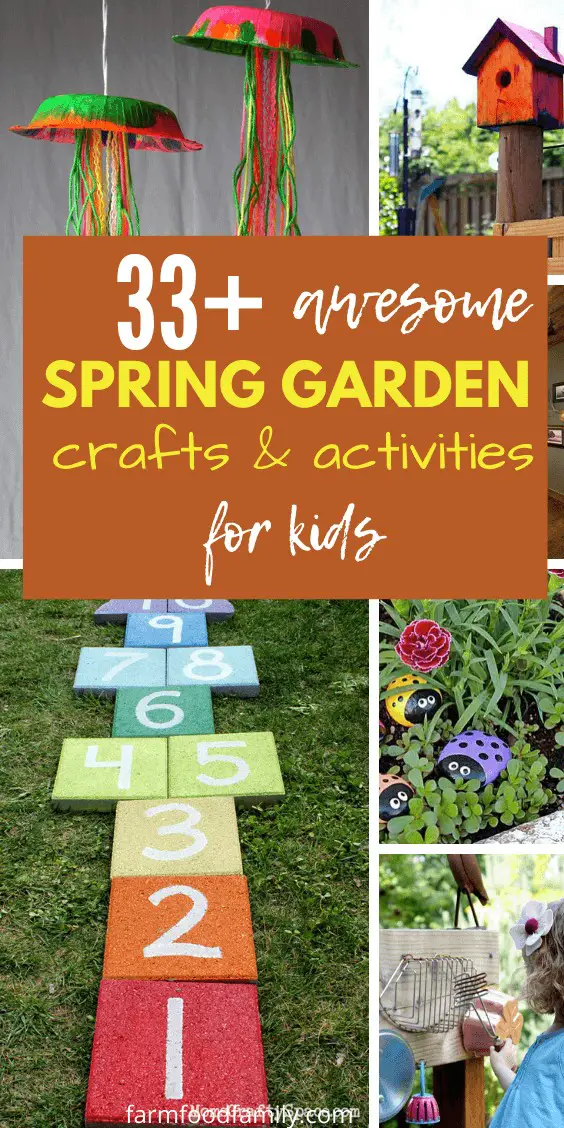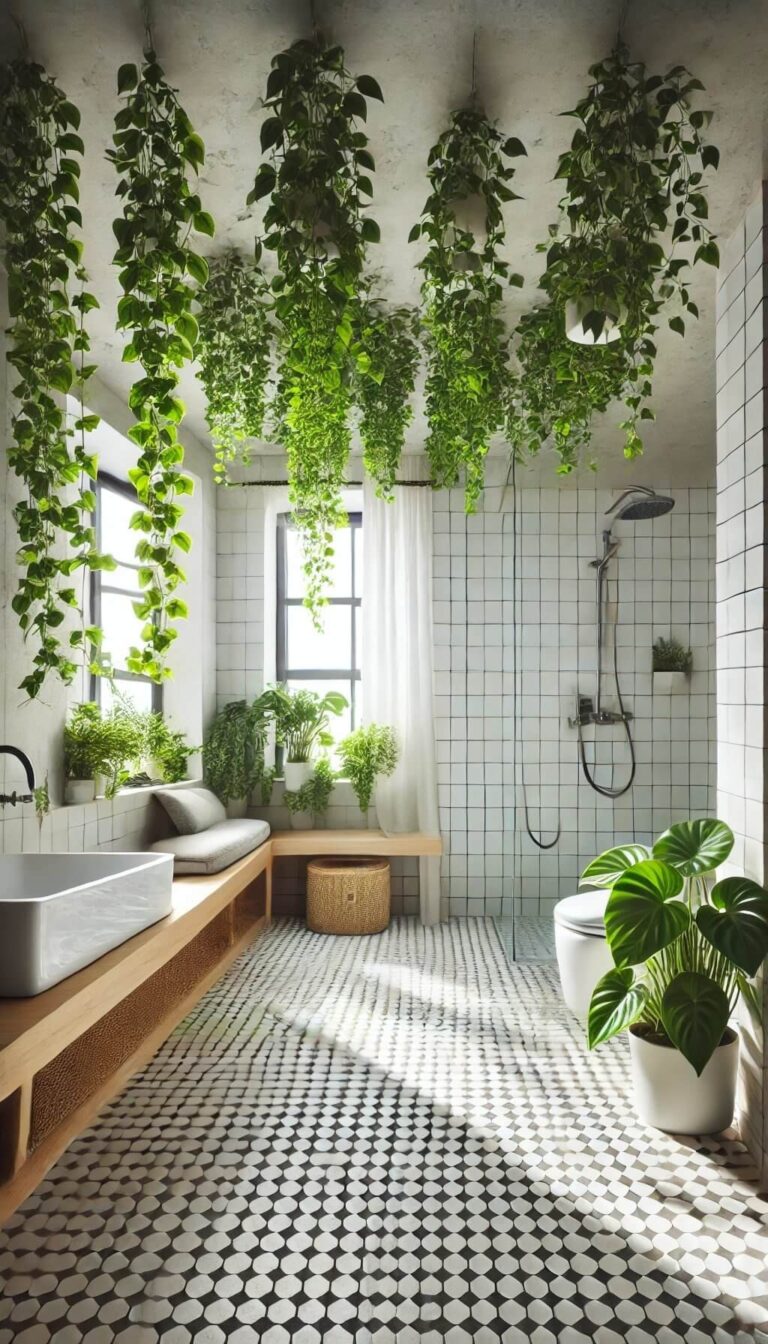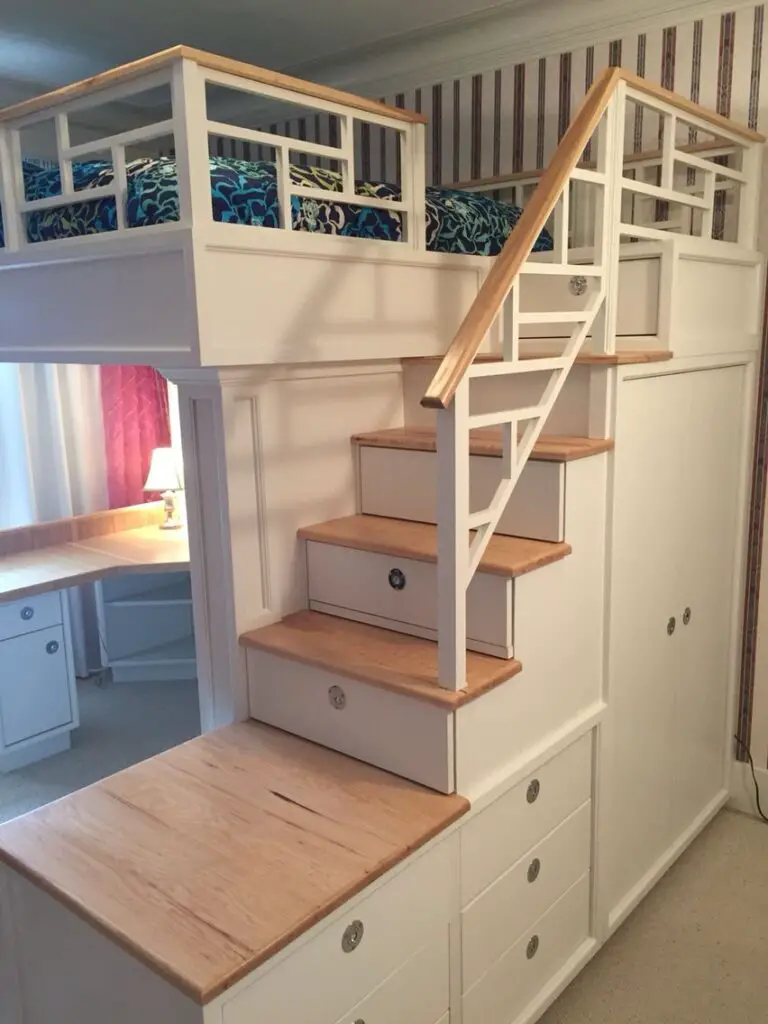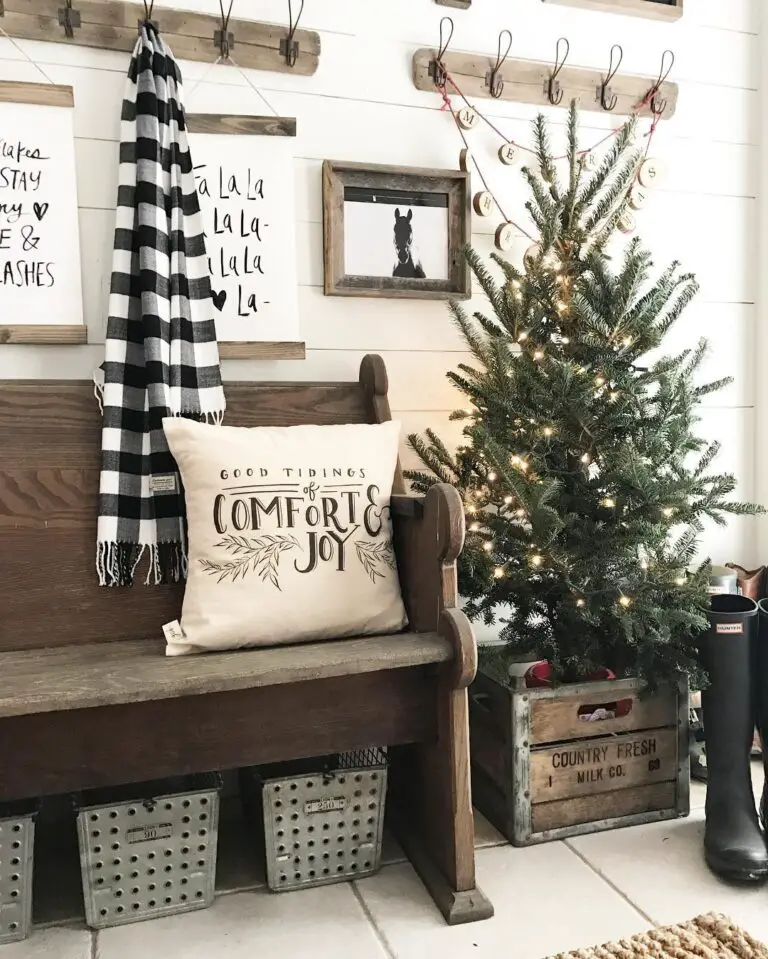50+ Sloped Backyard Landscaping Ideas On A Budget (Pictures)
Are you tired of looking at your sloped backyard as a source of frustration rather than relaxation? The good news is that with some creativity, planning, and strategic thinking, you can transform this challenging space into a beautiful and functional outdoor area without breaking the bank. Sloped landscapes present unique problems such as erosion, poor drainage, and limited flat space for activities, but these issues can be addressed with a little bit of ingenuity and a well-thought-out plan.
In fact, many people have successfully turned their sloped backyards into stunning oases that they can enjoy all year round. To get started, it’s essential to understand the common issues that arise when working with a sloped landscape and how you can use various budget-friendly strategies to mitigate these problems. This includes utilizing terracing, retaining walls, ground cover plants, and more.
With some careful planning and execution, you can create a beautiful and functional outdoor space that you’ll love spending time in, all without having to spend a fortune.
Understanding Slope Challenges
In many cases, sloped backyards present homeowners with a distinct set of obstacles. The list of potential issues is extensive, encompassing erosion, drainage problems, and a shortage of usable outdoor areas. It’s essential to tackle these challenges not only for the sake of your home and family’s safety but also to unlock the full aesthetic potential of your yard. This comprehensive approach will ultimately lead to a more functional and visually appealing outdoor space.
Common Issues with Sloped Backyards
The challenges of owning a sloped backyard are multifaceted and require a comprehensive approach to address them effectively. Erosion, for instance, poses a significant threat as it can lead to substantial soil loss, causing damage to the landscape and potentially compromising the foundation of your house. To mitigate this issue, consider planting ground cover plants that help stabilize the soil or constructing retaining walls to prevent erosion.
Another critical concern is drainage, which can result in water damage to both your garden and home if not managed properly. Installing French drains or creating rain gardens can help regulate water flow and prevent pooling. Finally, the limited usable space in a sloped backyard can be frustrating as it hinders the ability to fully utilize the area for activities such as gardening, recreation, or simply enjoying an outdoor patio.
Techniques like terracing or adding raised decks can create flat, functional areas that enhance your overall backyard experience.
The Significance of Addressing These Challenges
While preventing damage is a crucial aspect of handling slopes in an outdoor space, it’s equally important to consider their aesthetic and functional potential. A well-managed slope can be transformed into a captivating feature that adds depth and interest to your garden, offering unique opportunities for creative landscaping and design that flat areas simply cannot match.
When done safely and with thoughtful consideration, slopes can become the perfect setting for outdoor activities such as gardening, entertaining, or simply unwinding – providing an inviting backdrop that enhances the overall experience.
Planning and Design Tips
To embark on a successful journey of creating a stunning and practical sloped backyard, it’s crucial to begin with a well-crafted plan. This foundation lays the groundwork for avoiding potential pitfalls and ensuring a seamless execution of your vision, all while staying within your designated budget. In this section, we’ll delve into the preliminary stages of planning and design, highlighting the significance of meticulous preparation in order to achieve the desired outcome.
Importance of a Well-Thought-Out Plan
Transforming a sloped backyard into an inviting outdoor space requires a clear and comprehensive plan. Without one, you may find yourself stuck in a cycle of trial and error, wasting time and resources on solutions that don’t effectively address your unique needs. A well-crafted plan, on the other hand, enables you to anticipate potential challenges, weigh all your options carefully, and make informed decisions about how to achieve your desired outcome.
By doing so, you’ll be able to create a space that not only meets but exceeds your expectations.
Consultation with a Landscaping Professional
Consulting with a landscaping professional may seem like an added expense, but it can ultimately save you money in the long run by providing valuable insights and expert advice. These experts can help you navigate complex landscape design elements, such as slopes, and offer cost-effective solutions to ensure your project stays within budget. They can also identify potential pitfalls and suggest improvements to avoid costly corrections down the line.
Moreover, they can assist in developing a detailed plan that takes into account your specific needs and budget constraints.
Using Online Resources and Software
With the abundance of digital tools available today, designing and visualizing your backyard project has never been easier. From simple layout planners to advanced software offering 3D visualization, you can explore different design ideas, experiment with layouts, and get a realistic sense of how your plans will come together before breaking ground.
This is especially helpful when it comes to envisioning the impact of structural changes like terracing or retaining walls on your sloped backyard’s appearance and functionality. Online guides and blogs offer a wealth of inspiration and tips, while design software allows you to plan and visualize your project in detail. Even social media platforms can be used to share your ideas and get feedback from others, giving you the opportunity to refine your design before making any final decisions.
Budget-Friendly Slope Management Strategies
While transforming a sloped backyard into a functional and visually appealing space may seem daunting, the right techniques can make it a reality. One efficient method is to employ terracing, which involves creating multiple flat areas that are perfect for gardening or relaxation purposes. This section will explore how terracing can be used to create usable spaces and provide practical DIY tips for building terraces using affordable materials.
Terracing Explained
Terracing is an ancient technique used globally to cultivate steep land, not only preventing erosion but also creating multiple levels of usable space for gardening, seating, or other outdoor activities. This approach involves cutting flat platforms into the slope, with each level supported by a retaining wall. Terracing can be a rewarding project that enhances the functionality and aesthetics of your sloped backyard, making it an attractive DIY endeavor.
When building terraces, consider using budget-friendly materials like timber and stones. Timber offers an affordable and easy-to-work-with option, but requires treatment to prevent rot. Stones provide a durable and natural-looking solution, although placing them can be labor-intensive. Choose pressure-treated wood for longevity and ensure proper drainage behind the walls to prevent water pressure from building up.
Stones, whether natural or man-made, can create terraces that blend beautifully with the landscape. To keep costs down, look for local sources of stone and consider using a mix of sizes for a more natural appearance.
Ground Cover Plants
When it comes to tackling erosion in sloped backyards, ground cover plants offer a clever solution. These versatile plants spread across the terrain, utilizing their roots to hold soil in place while adding visual appeal with minimal upkeep required. By selecting species that are both attractive and adept at preventing soil loss, you can transform a troublesome slope into a thriving, low-maintenance garden.
To make an informed decision, consider the unique characteristics of various ground cover options. For instance, creeping thyme is not only fragrant but also drought-resistant, making it an economical choice. Sedum, on the other hand, boasts vibrant colors and can thrive in poor soil conditions. Ivy, while providing dense coverage that prevents erosion, may require moderate maintenance to prevent invasive growth.
By choosing ground cover plants that balance aesthetic appeal with functional benefits, you can create a lush and eco-conscious garden that not only combats erosion but also saves time and resources.
Retaining Walls
Retaining walls are a vital component in slope management, serving as a barrier against soil erosion while creating usable outdoor spaces. Beyond their functional purpose, they also add visual appeal to the landscape. To construct retaining walls without breaking the bank, consider using affordable materials such as concrete blocks, bricks, or repurposed items. These options not only provide a cost-effective solution but also contribute to the overall aesthetic of your backyard.
By thinking creatively about material selection and usage, homeowners can achieve significant savings while infusing their landscape with a personalized touch.
Pathways and Steps
Incorporating pathways and steps into a sloped backyard not only enhances accessibility, but also adds a touch of aesthetic appeal without breaking the bank. The key is to select inexpensive yet effective materials that can withstand the elements and maintain their structure over time. When it comes to choosing the right material for your project, there are several options available. Gravel, for instance, offers an affordable and easy-to-shape solution that can be installed quickly.
To ensure its stability, however, a stable base must be prepared first. On the other hand, mulch provides a natural look while also preventing weeds from growing. While it requires annual refreshes to maintain its appearance, the result is well worth the effort. For those looking for an eco-friendly option, recycled pavers are a great choice. Not only are they cost-effective, but they’re also durable and can be laid on a sand base for even placement.
When installing pathways and steps, it’s crucial to prepare the base correctly and ensure good drainage to prevent the materials from shifting or washing away. By following these simple tips, you can create functional and decorative features that add structured beauty to your garden.
What can I do with a small sloped backyard?
When it comes to transforming your sloped backyard, the possibilities are truly endless. One option is to design a stunning view deck or terracing system that takes advantage of the natural slope. You could also create a beautiful flower trail that winds its way down the hillside, adding color and texture to the space. For added visual interest, consider incorporating wood railings or a feature path that highlights the unique shape of your yard.
And if you’re feeling extra adventurous, why not combine two or three of these ideas to create a truly show-stopping outdoor space? The key is to be creative and think outside the box, rather than viewing a sloped backyard as somehow inferior to a leveled one.
Can you level out a sloped backyard?
When considering leveling a sloped backyard, it’s likely due to concerns about water runoff, erosion, and mowing difficulties. While achieving a level yard may solve these issues, it comes with its own set of challenges. Taking on the task yourself can be arduous, requiring significant physical effort and time. Moreover, you’ll need to protect your clothing from stains and dirt.
To make the process more manageable, we suggest investing in a comfortable gardening kneeler and seat, allowing you to complete the task efficiently and minimize wear and tear on your clothes.
How much does it cost to level a sloped backyard?
Leveling a sloped backyard can be a daunting task, but it’s crucial to weigh the costs against the benefits. According to industry experts, the cost of leveling a sloped yard can range from $2 to $20 per cubic yard of dirt, depending on the complexity of the project. For a typical-sized backyard, this translates to an average cost of $1900 with professional laborers or $1200 if you opt for DIY.
While a multileveled elevation can add visual interest to a property, sloped yards come with unique challenges, such as soil erosion and increased maintenance needs. Nevertheless, these obstacles shouldn’t deter homeowners from transforming their slope backyards into beautiful outdoor spaces. If you’re looking for budget-friendly ideas to elevate your slope backyard, consider the following styles and arrangements.
23 Sloped backyard ideas on a budget
When discussing the possibilities for a sloped backyard, it’s essential to consider the versatility of the space. However, to make the most of this unique environment, it’s helpful to focus on the most popular backyard design concepts tailored specifically for sloping and uneven yards.
Unique Water feature with watering cans
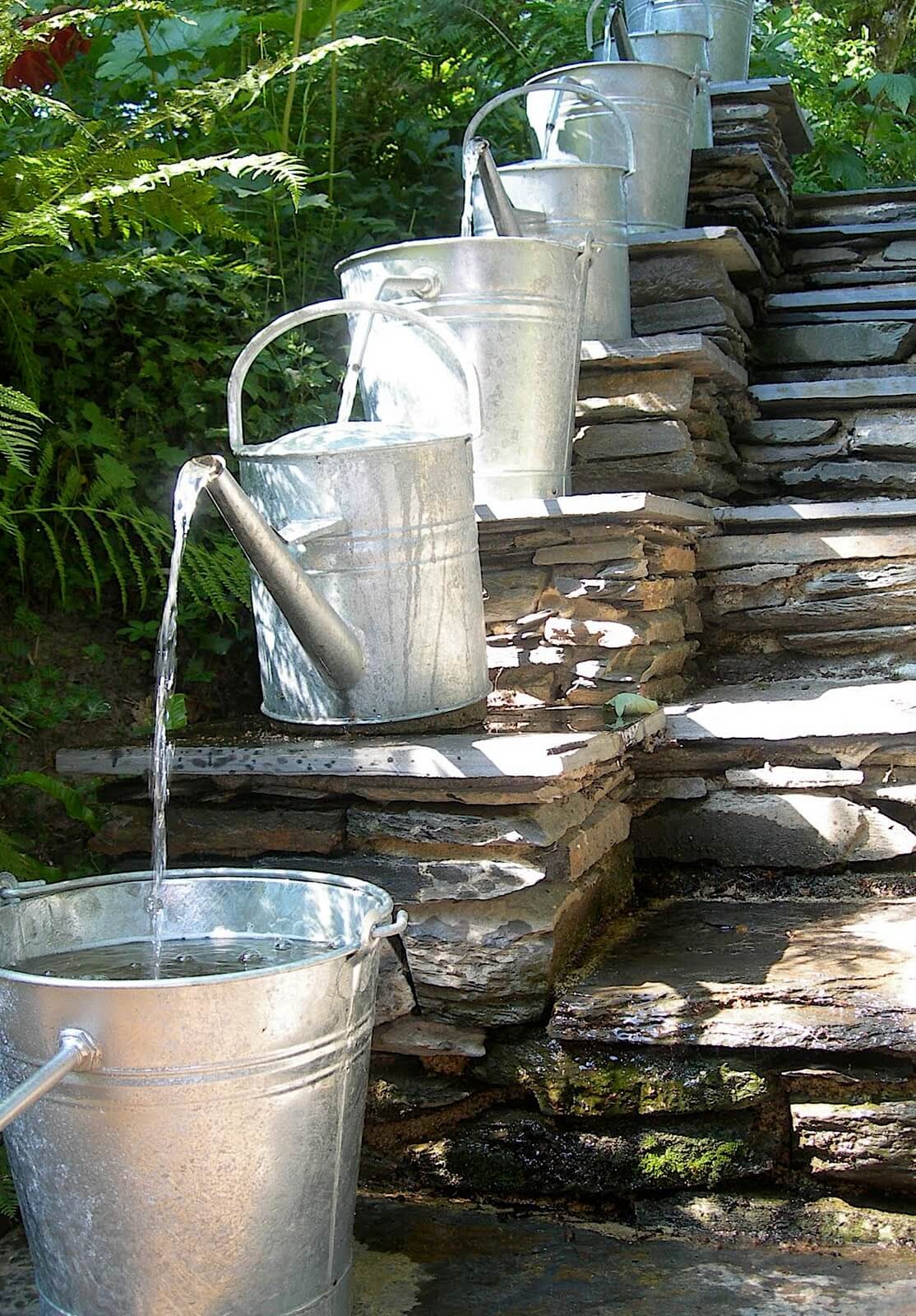
Having a water feature in the backyard is often considered a staple element, as it skillfully balances the natural slope of the terrain. Not only does it provide visual interest, but it can also serve as the central focal point for your landscaping design. However, it’s important to note that you don’t necessarily need a traditional fountain or pool to create this effect.
A creative alternative could be to design a descending water flow using a series of water cans placed at each stair level, adding a unique and visually striking element to your outdoor space.
Tumbled Paver Patio
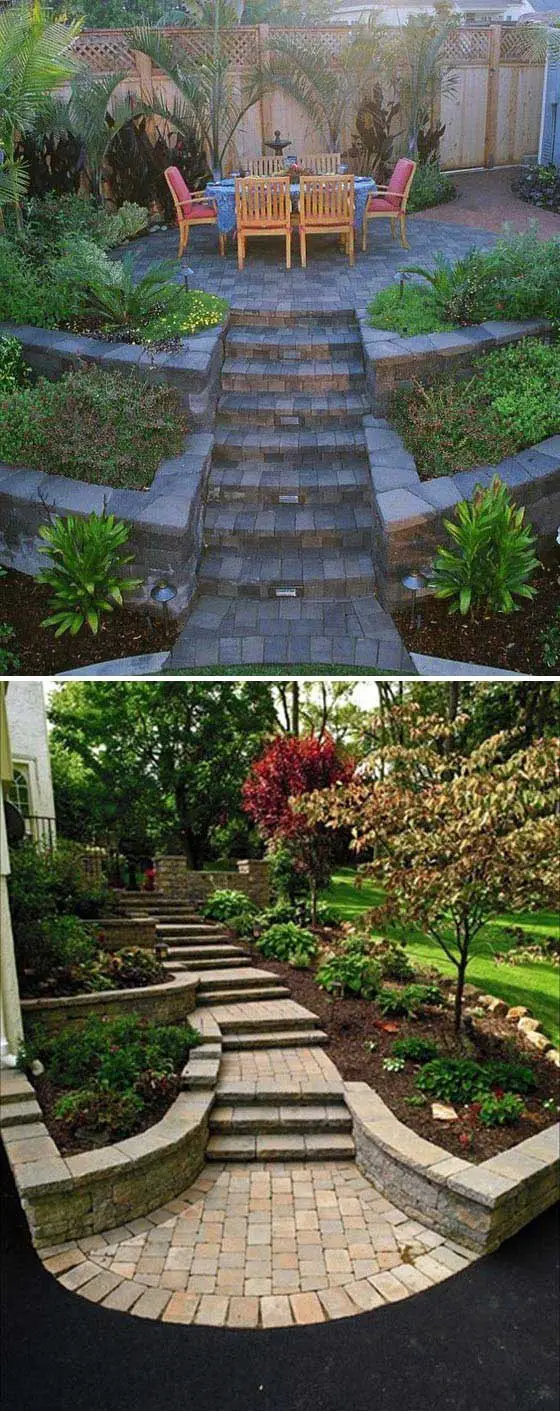
Take your garden view to new heights by transforming your backyard into a serene oasis. A patio overlooking your lush greenery is the perfect way to do so. For a cohesive design, use concrete pavers not only on the planters along the stairs but also on the flooring of the patio and stairs themselves. This thoughtful touch will create a calming atmosphere that’s perfect for gathering with friends and family.
Stonework landscaping
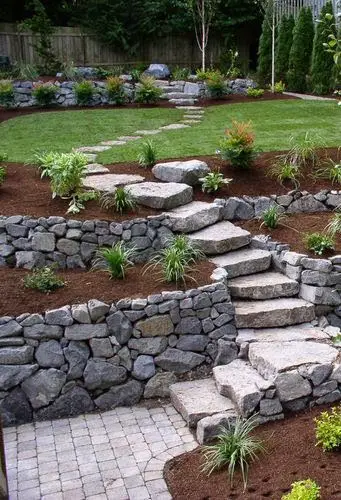
Sloped backyards are often elevated by the harmonious union of natural elements and hardscaping. Stone, in particular, creates a striking visual connection between the ground level and the elevated areas above. Whether used for a meandering walkway, ornate planters, or even a backyard fire pit, stairs leading to a barbeque area, extended deck, or pergola, stone’s organic appeal can be leveraged to create a cohesive and inviting atmosphere.
4-7. Stone stairs on a green patch
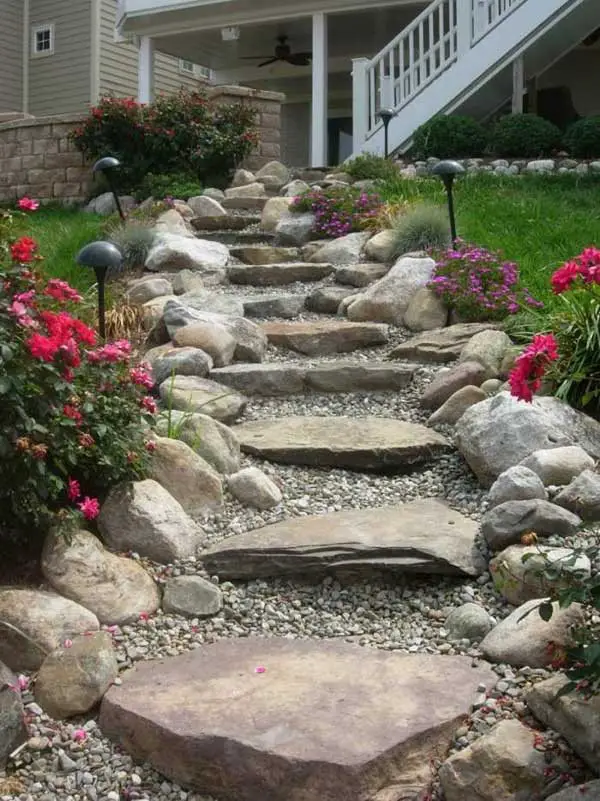
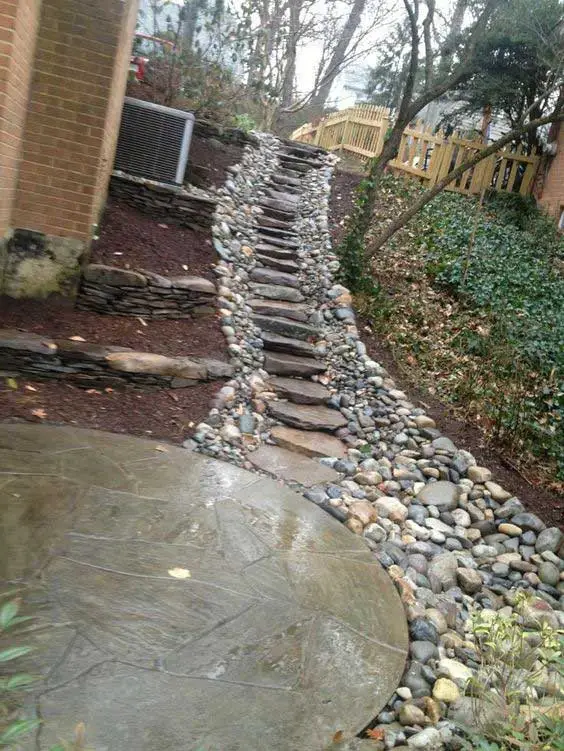
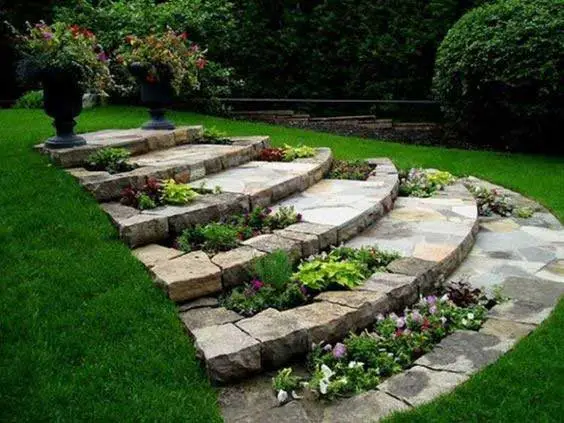
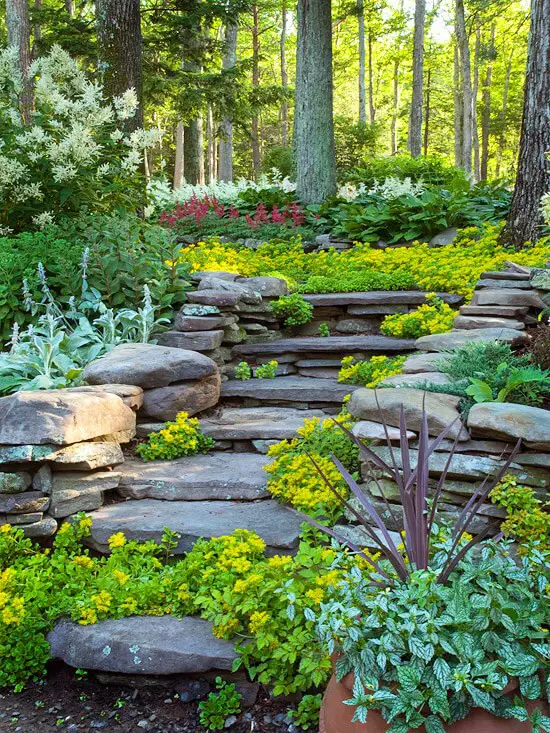
While installing grass turf on your entire sloped backyard can be a great start, it’s crucial to introduce other elements to create visual interest. Beyond the obvious importance of flowering plants, consider incorporating stone stairs within a lush green area, as seen in this example. This will not only add texture and dimension but also provide a unique focal point that encourages exploration.
Serene backyard seating on a slope
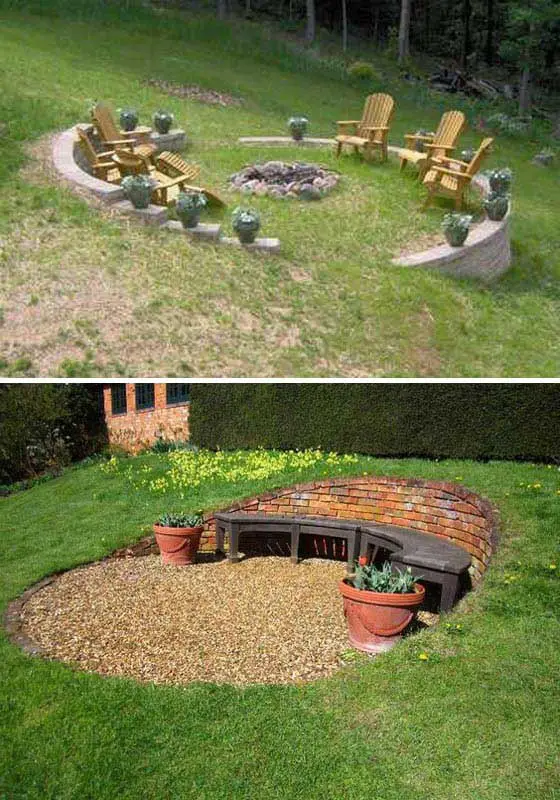
Transforming your backyard into an idyllic retreat is just a few creative ideas away. Consider building sheltered seating in a sloped terrain that evokes the charming ambiance of an old English manor in the countryside. To add to the rustic charm, incorporate repurposed wood to create benches that blend seamlessly with the surrounding landscape. For a touch of elegance, use light-colored pea gravel for accent flooring, allowing the natural beauty of your backyard to shine through.
Slabs of natural stone and steps
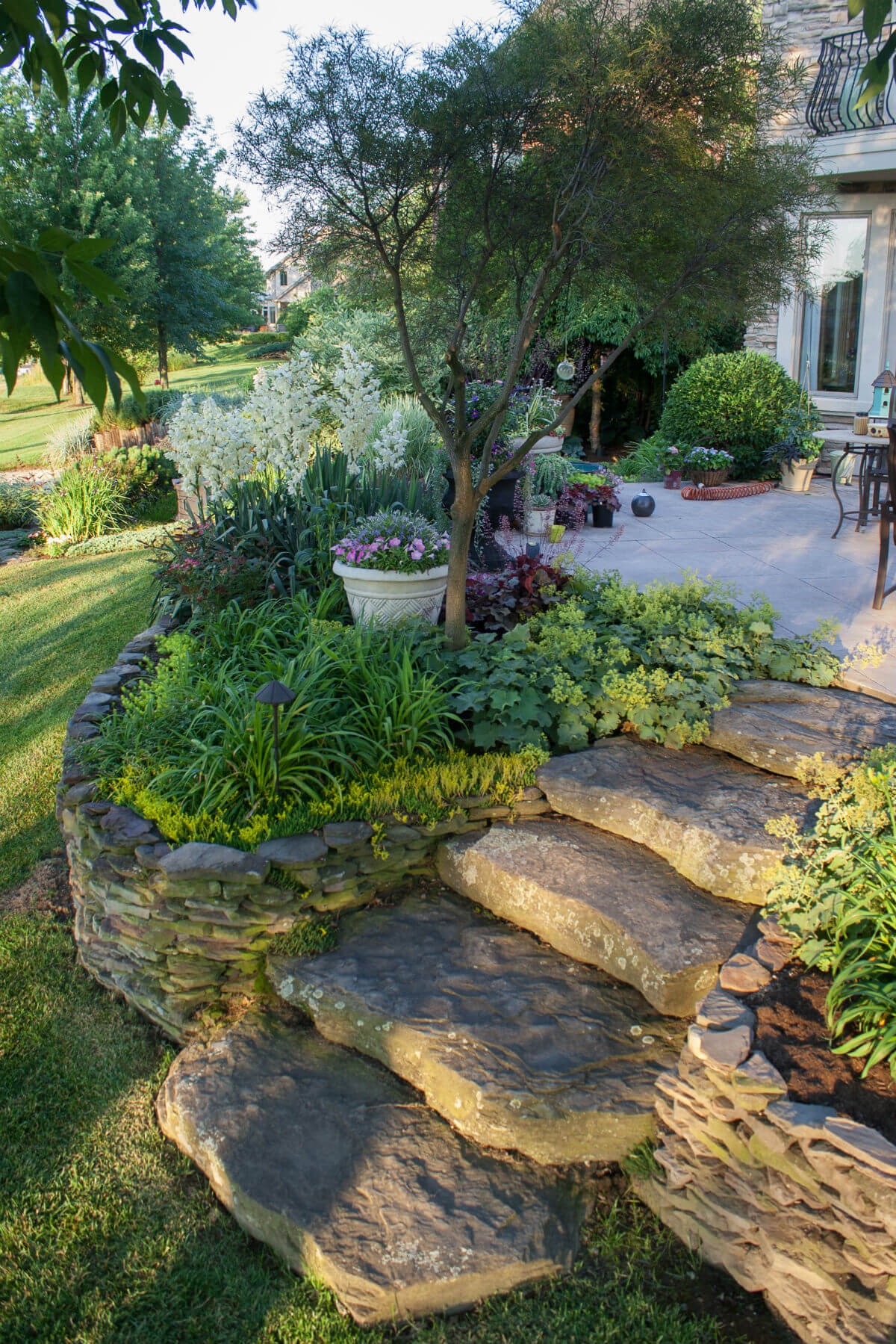
The visual harmony achieved by pairing low-growing shrubs with seasonal flowering plants creates a stunning backdrop for a sloped backyard garden. The natural stone slabs, used to border planters and serve as stairs, add a cohesive touch. To enhance the ambiance, incorporate solar-powered lights in the planters and incorporate rattan seating into the patio design. With this style, you can set the tone without requiring elaborate accent pieces to complete your outdoor space.
Polished wood: Steps, walls with sleepers

The allure of polished wood is undeniable. When it comes to creating an inviting outdoor space, there’s no better material than hardwood. Whether you’re working with reclaimed pieces or repurposing existing ones, polishing the wood can transform it into a stunning feature that serves multiple purposes. Imagine a stairway leading up to a cozy firepit, a deck perfect for al fresco dining, or a beautifully landscaped backyard garden.
The versatility of polished wood is further amplified when incorporating box-type designs, which not only provide a multifunctional stair but also offer ample seating opportunities in the form of wooden benches.
Small backyard

Slide on hill
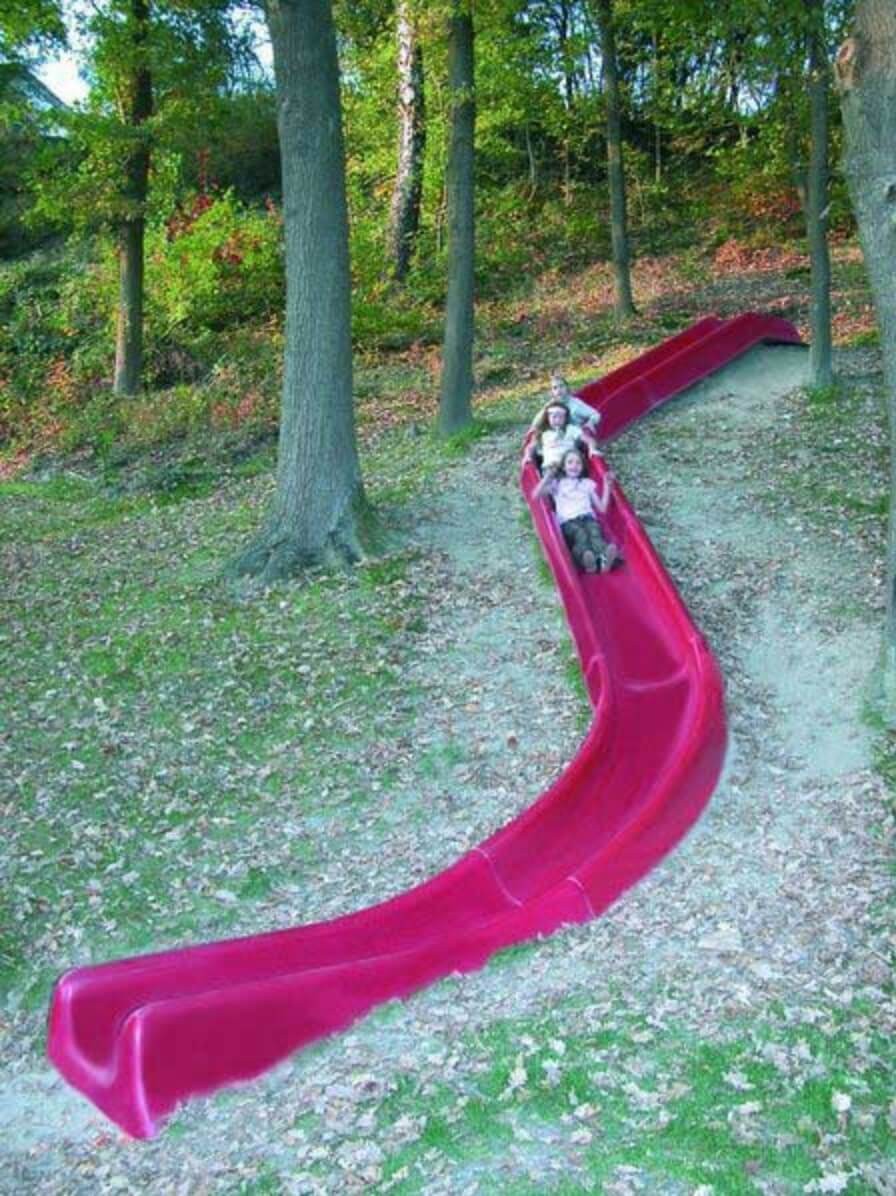
Build gravel stairs on a hillside
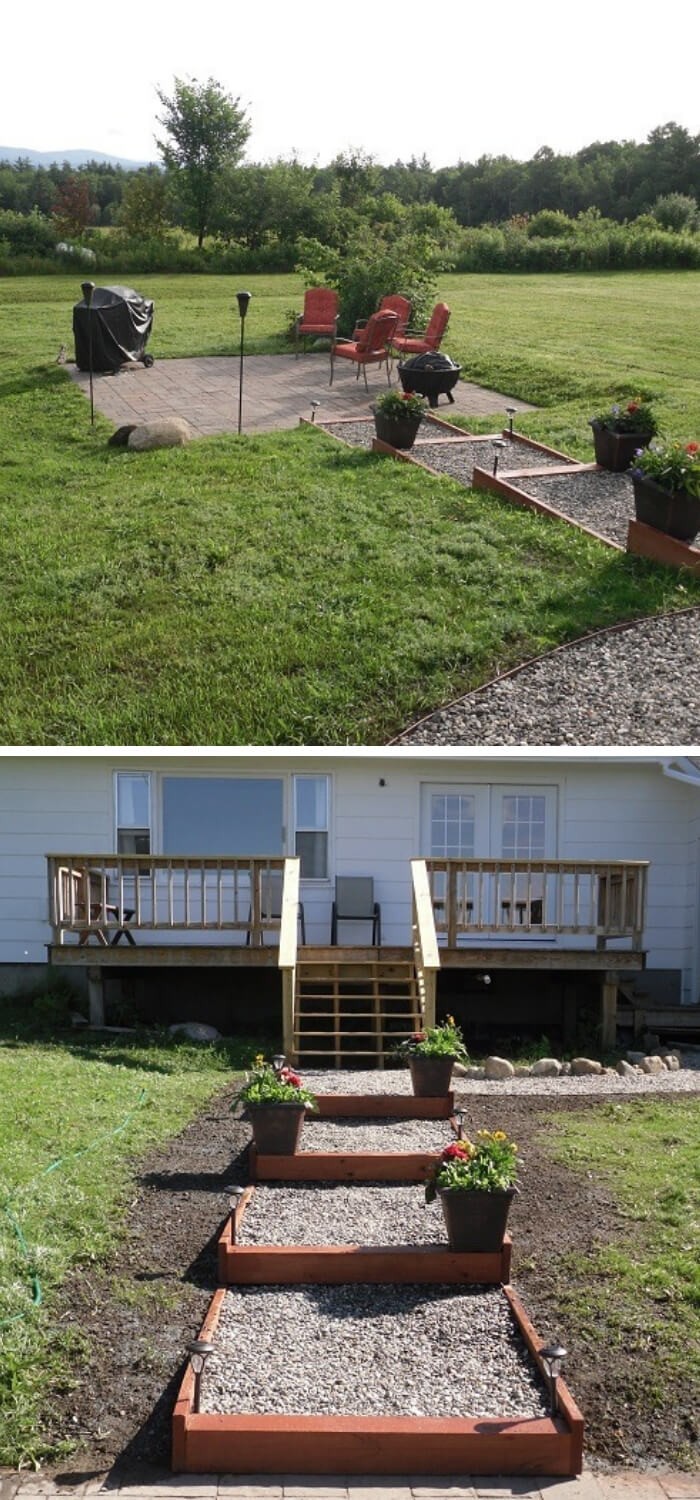
While wood and natural stone slabs are common choices for flooring, gravel is often overlooked as an option, especially when it comes to sloped backyards. A budget-friendly idea for tackling these slopes is to utilize boxed gravel. This involves encasing fine gravel within repurposed wooden boxes, creating a unique and visually appealing feature that can seamlessly integrate with other backyard elements like paver flooring, barbeque grills, and garden lights.
Nice slope with abundant boxes

Imagine transforming your spacious sloped backyard into a picturesque Tuscan vineyard or garden. This stunning landscape feature is achievable by constructing large, elevated garden beds across the lush turf. The beauty of this design lies in its versatility – you can opt for uniform rows featuring a single type of plant or veggie, or take a more eclectic approach and fill each box with diverse varieties. The possibilities are endless!
Raised beds
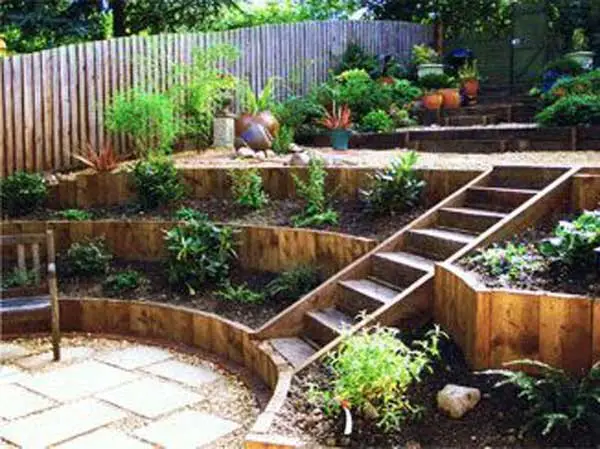
16-19. Tiered

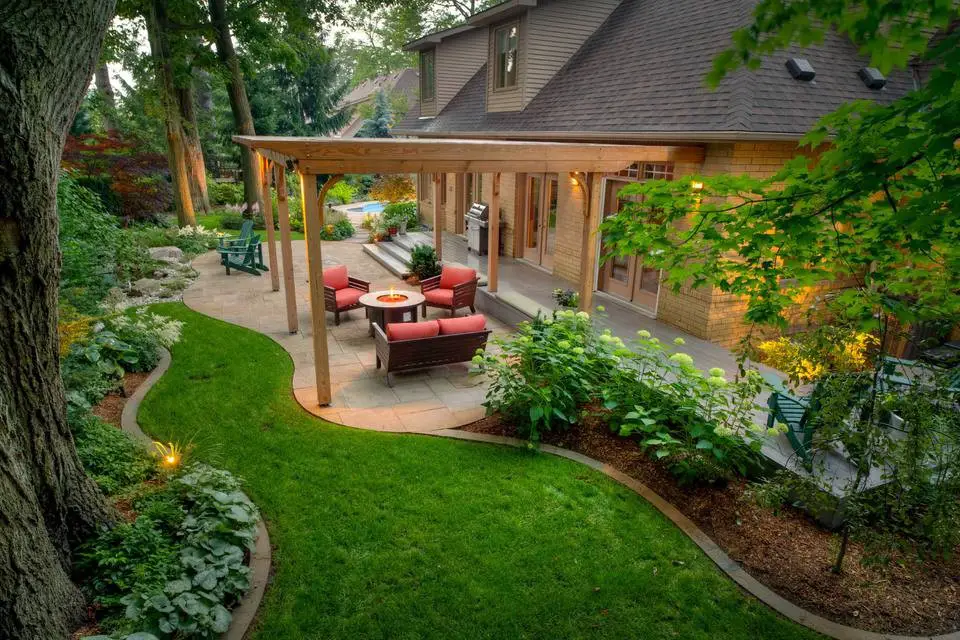
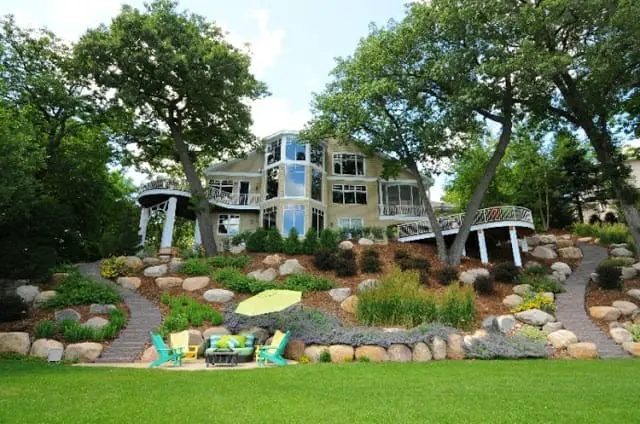
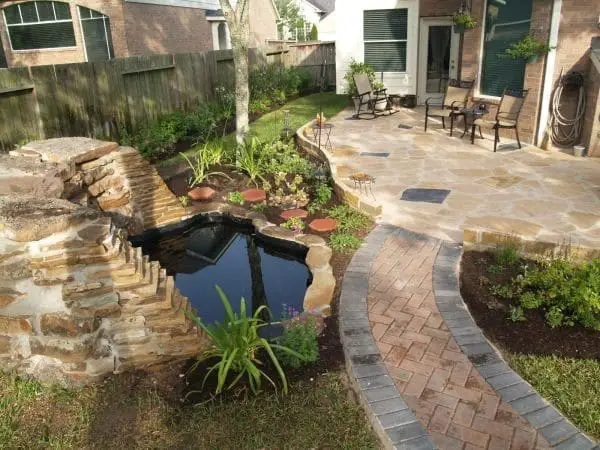
When envisioning a luxurious Beverly Hills or Mediterranean-inspired abode, incorporating tiered designs for sloped backyards can add an air of sophistication while commanding attention. To ensure the design complements your home’s overall aesthetic, opt for materials that not only withstand the unique topography but also mitigate erosion and water runoff concerns. Furthermore, experimenting with layering plants and other elements can create a visually appealing oasis.
For inspiration, explore designs from renowned experts like Bob Vila and The Spruce.
20-23. Staircase
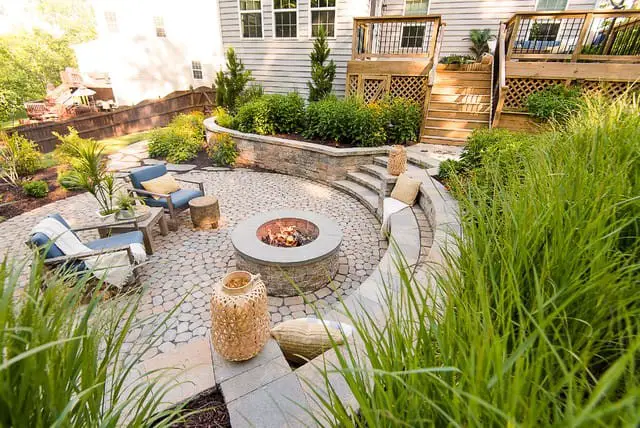

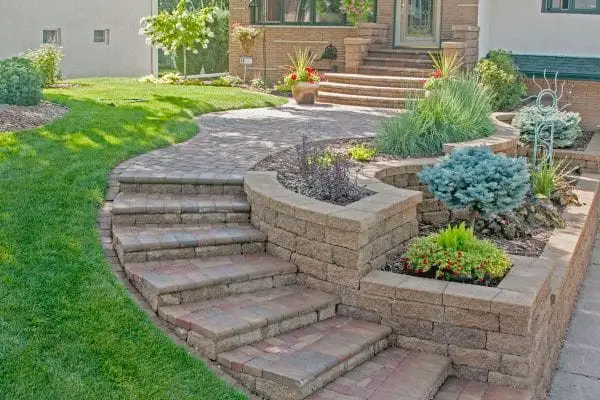
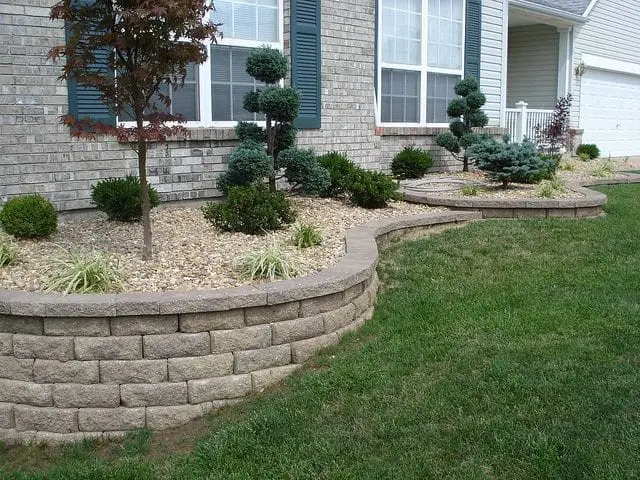
The most striking design element that can elevate the ambiance of any outdoor space is undoubtedly stairs. Whether crafted from natural stone, gleaming metal, or weathered wood, these structures have a unique ability to create a dramatic visual impact.
The journey up or down the steps becomes an exciting experience, as it promises to lead to a scenic destination – be it a lush backyard oasis, a pergola perfect for alfresco dining, a fire pit for cozying up with loved ones, or any other enchanting spot. Take inspiration from renowned landscape design experts like Houzz and Villa Landscapes, who have created breathtaking staircases that seamlessly integrate with their surroundings.
24-27. Water features
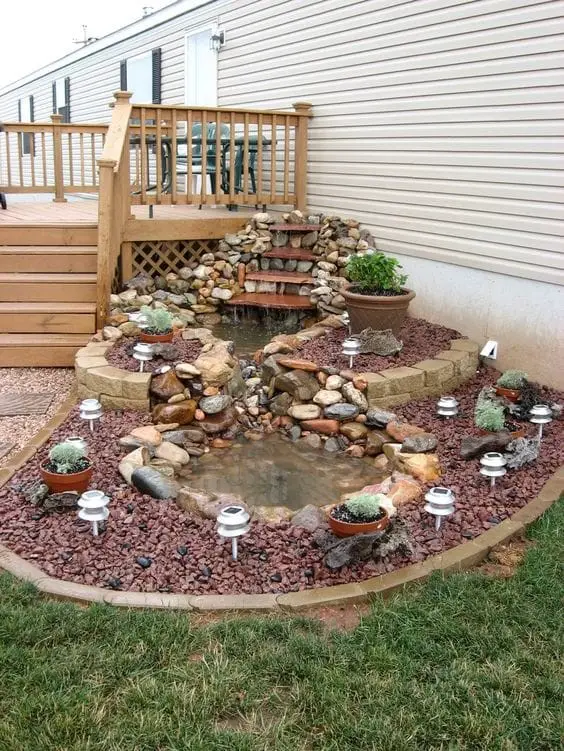

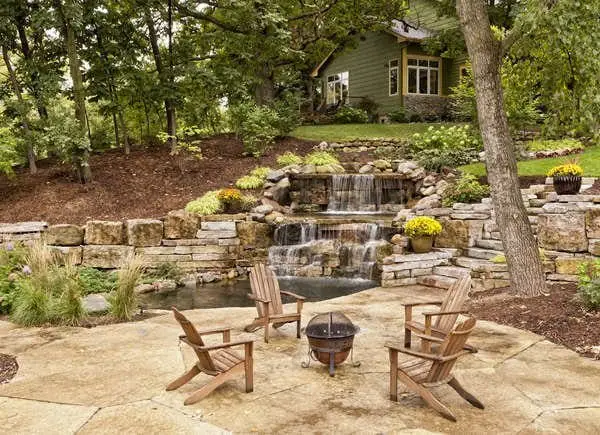
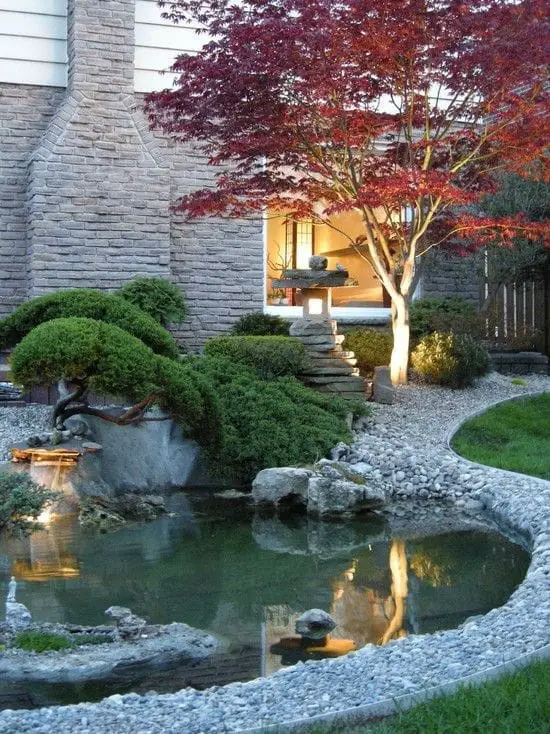
A beautifully designed water feature can elevate the ambiance of your backyard and provide a natural cooling system. A sloping yard offers an opportunity to incorporate wood, stone or concrete elements that add depth and mystery to the space. For inspiration on how to effectively integrate water features into a sloped backyard, consider exploring designs from sources like Demotivateur, Eat Anchor Hitch, Bob Vila, and Pinterest.
28-30. Retaining walls
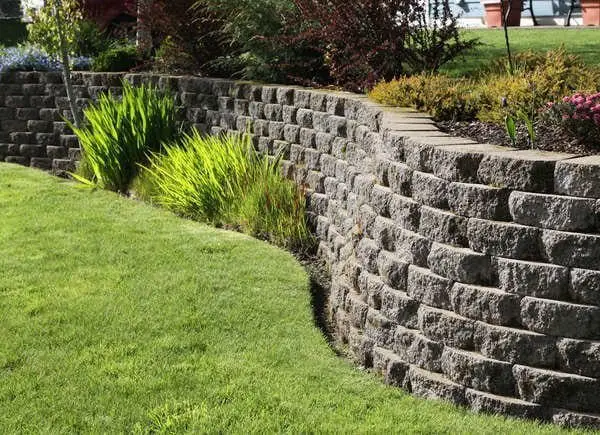
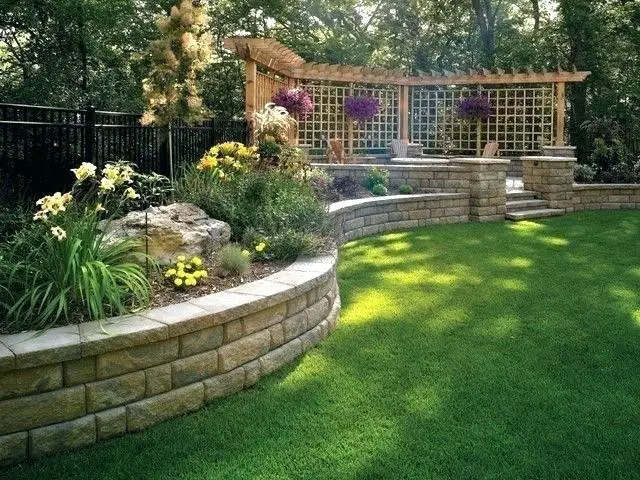
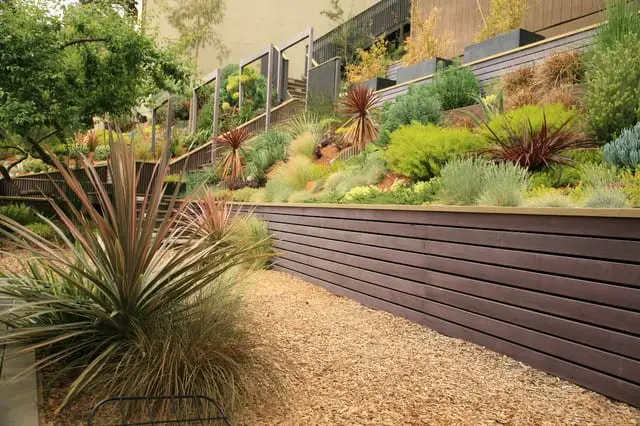
Creating an inviting outdoor space in your backyard is a wonderful way to enhance your home’s overall appeal. For homeowners with sloped backyards, retaining walls can be a game-changer. Not only do they provide a level surface for relaxation and entertainment, but they also offer a unique opportunity to add visual interest with flowering plants, palm trees, and other decorative elements.
By enclosing the walls with materials like wood, cobblestone, or concrete, you can create a truly cinematic experience reminiscent of those featured on Houzz. The possibilities are endless, allowing you to personalize your outdoor space and make it a true reflection of your personal style.
31-34. Decks and rails




When designing a sloped backyard, decks and rails are often considered default ideas to create a dramatic ambiance. Similar to tiers, stairs, and retaining walls, decks can elevate the outdoor space to make it perfect for hosting family gatherings. With some light work, incorporating woodwork, plants, stone elements, and a thoughtful theme, a decked area can become a sweet spot for all sorts of family celebrations.
For inspiration, take a look at designs from renowned sources such as The Home Depot, Better Homes and Gardens (BHG), and Archadeck West Country.
35-50. More sloped backyard ideas
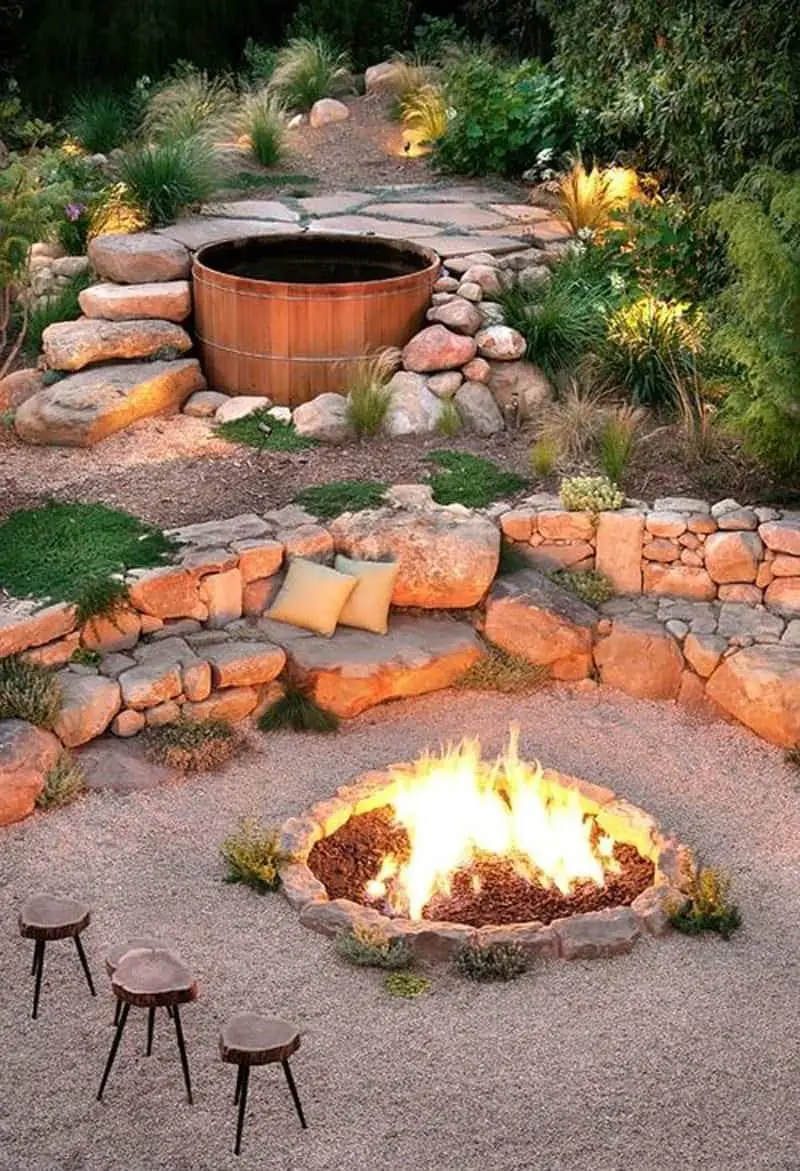
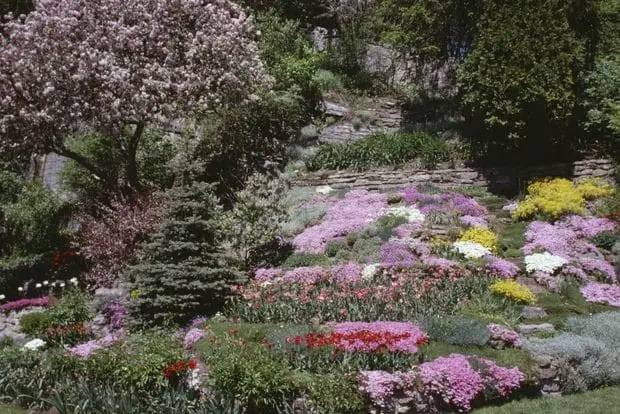
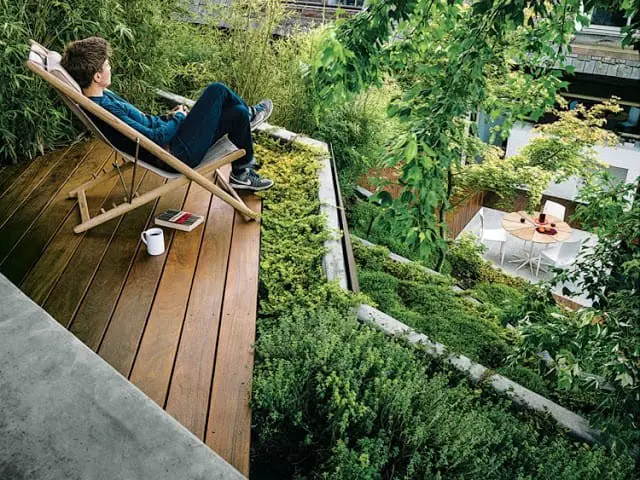
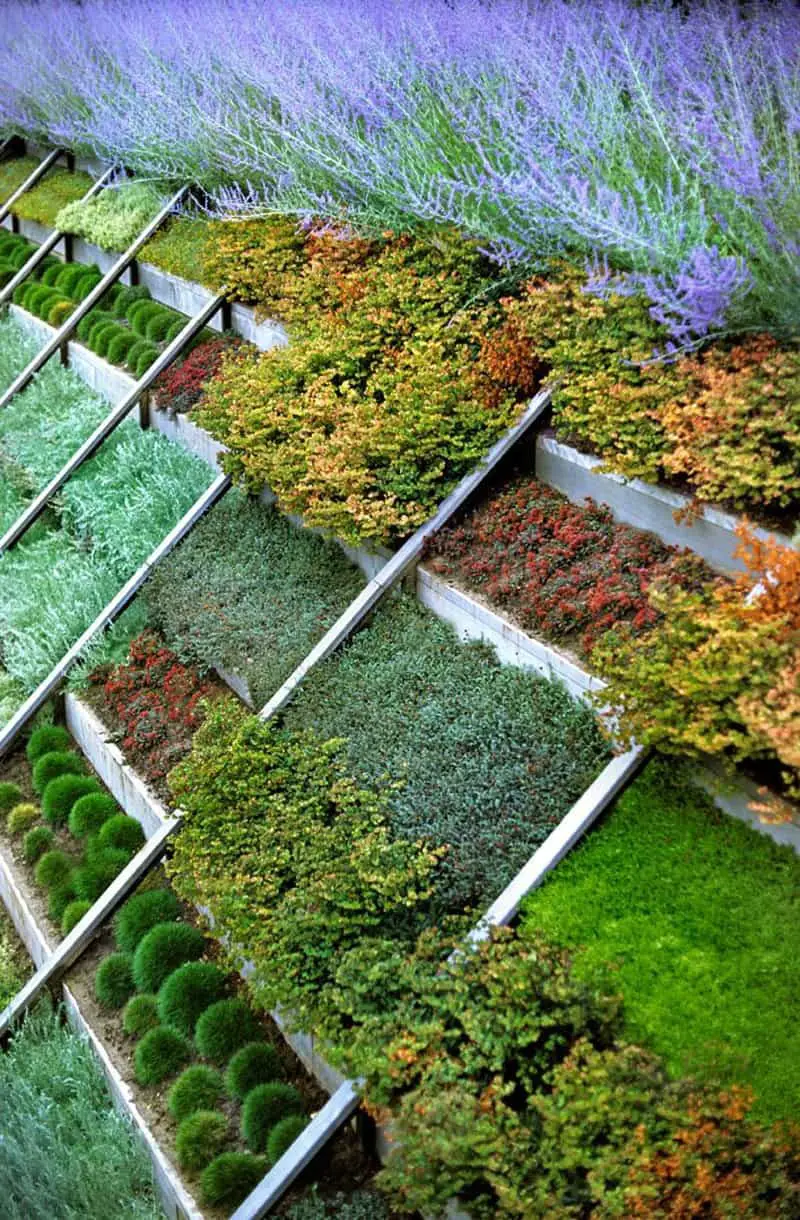
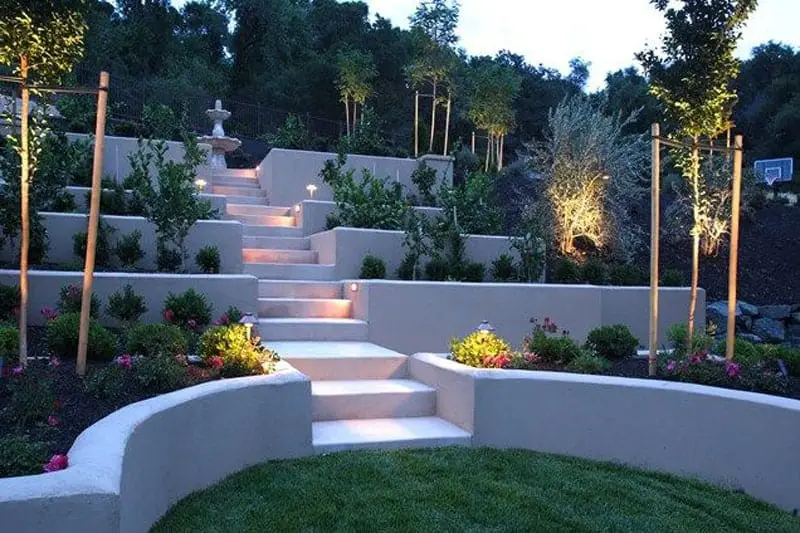
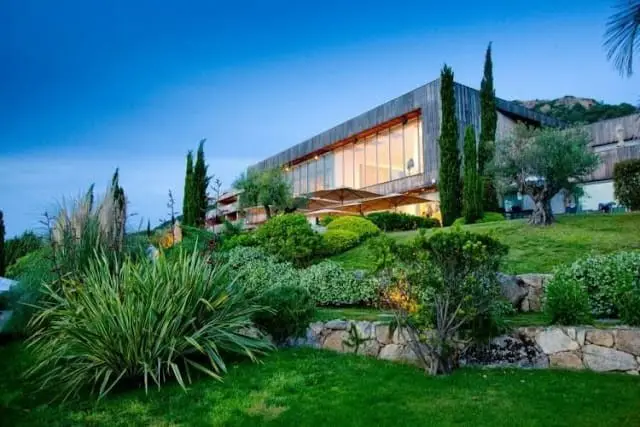
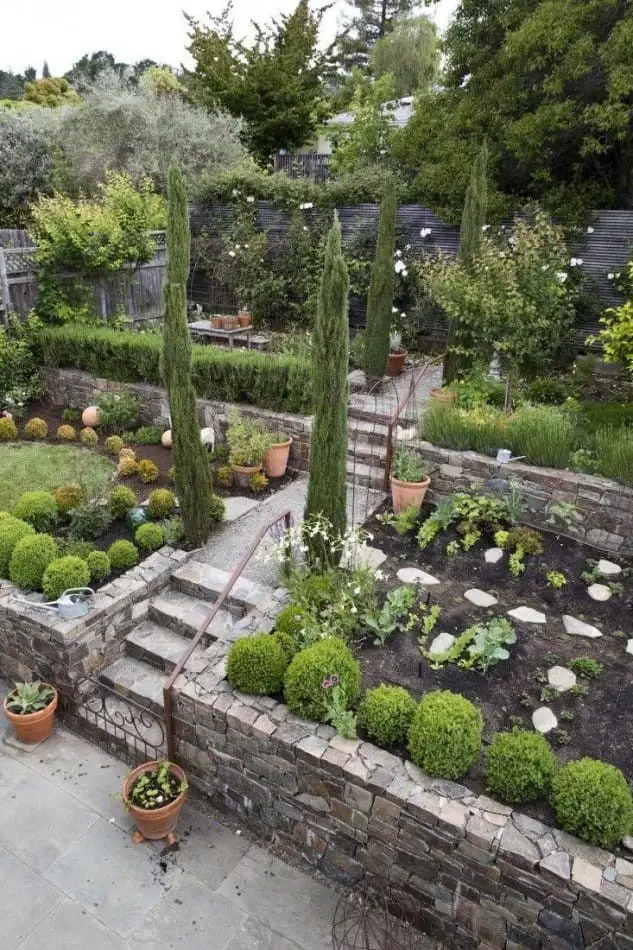
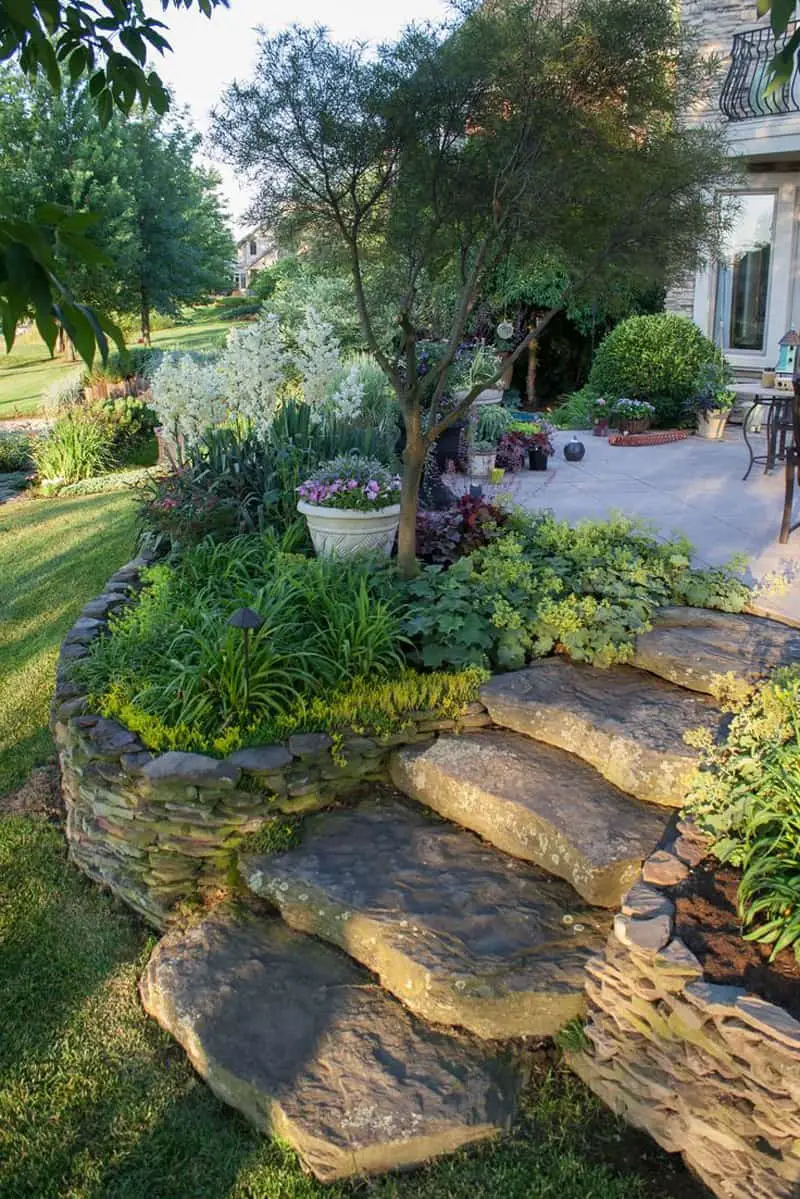
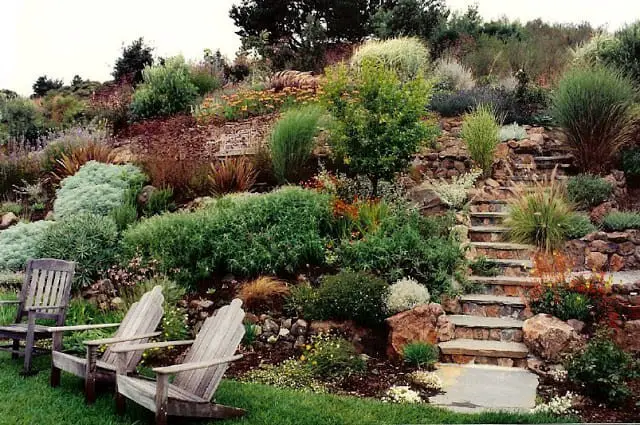
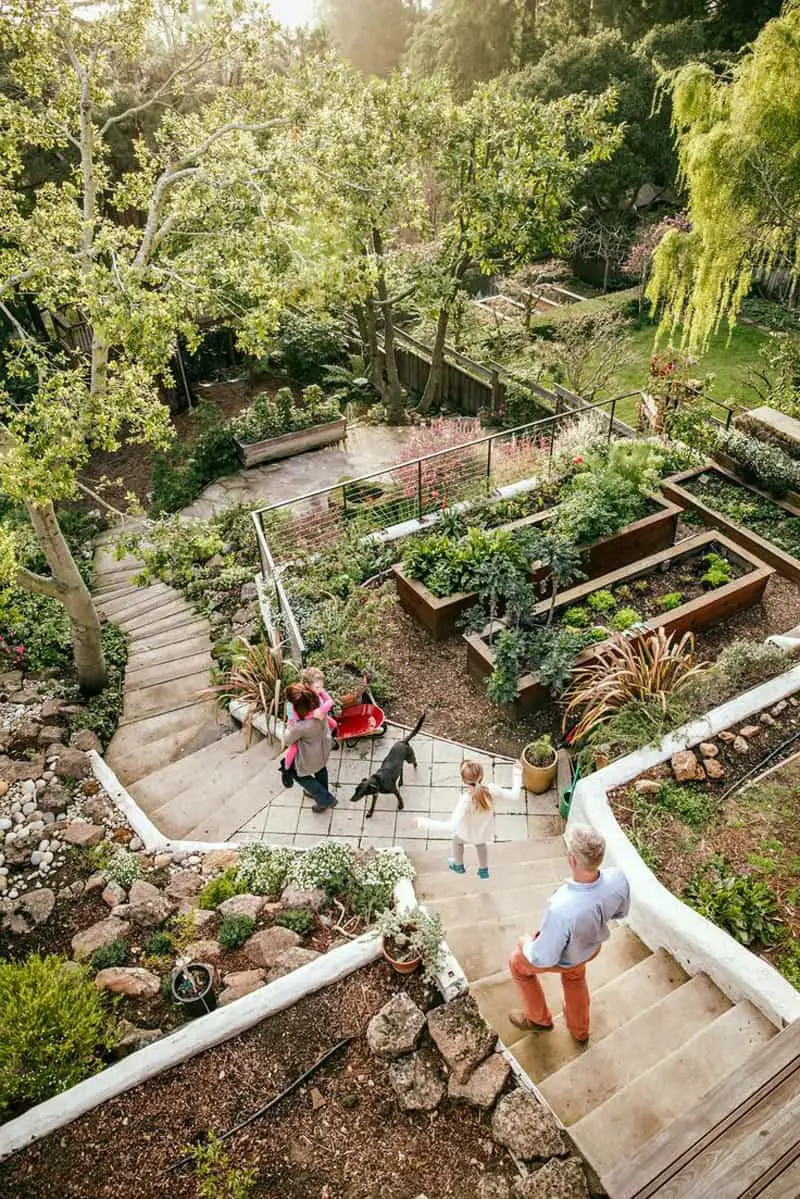
Natural steps for a sloped backyard
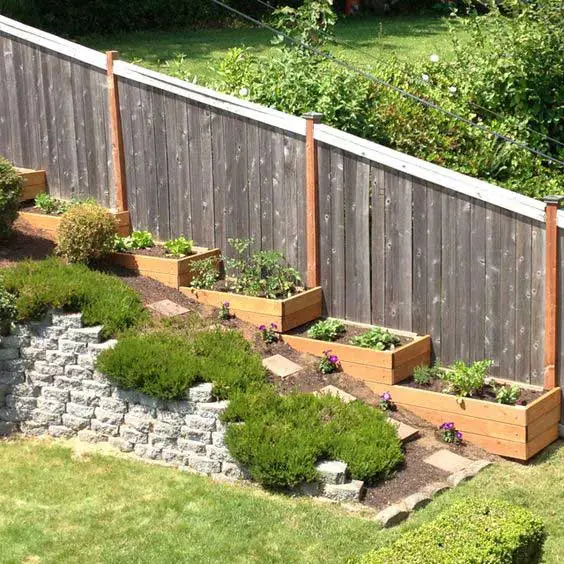
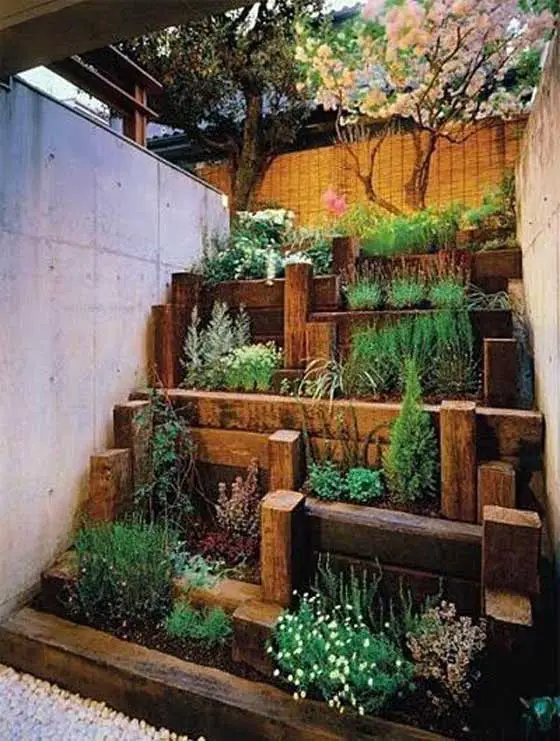
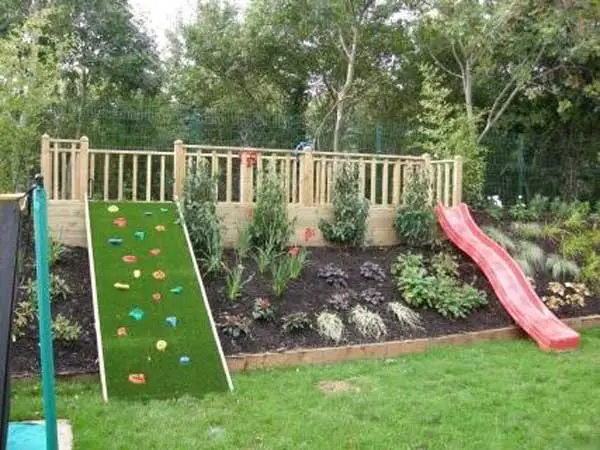
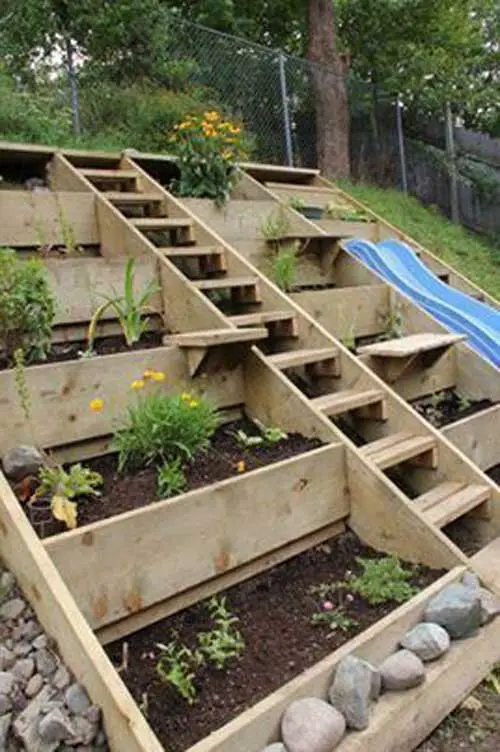


Imagine the delight of creating a charming pathway in your garden that not only adds visual appeal but also serves as a functional feature. To achieve this, you can use red soil or gravel as the base material and intersperse small stone tiles to create a meandering path. For added texture and visual interest, consider arranging wood box planters along the sides to double as rails and an organic patch for herbs or succulents.
Alternatively, raised garden beds can be used in place of planters, adding yet another layer of depth and dimensionality to your design. Finally, incorporate blue stones as a stair wall feature to create a striking focal point that adds a touch of elegance to your outdoor space.
Water Management Solutions
To safeguard your sloped backyard from erosion, minimize stormwater runoff, and preserve a thriving ecosystem, it’s essential to manage water effectively. This can be achieved by implementing clever solutions such as installing French drains or rain gardens, which not only mitigate the negative effects of heavy rainfall but also create opportunities for aesthetic enhancements.
Furthermore, incorporating native plants and trees into your landscape design can have a profound impact on local biodiversity, while also providing additional benefits like improved soil health and enhanced visual appeal.
Improving Drainage with French Drains and Rain Gardens
Proper drainage systems are essential for addressing water issues in sloped areas. By directing water away from homes and gardens, they significantly reduce the risk of water damage and soil erosion. Two effective solutions for achieving this are French drains and rain gardens.
French drains are particularly useful for capturing and redirecting sub-surface water.
To install one, a trench is dug along the affected area, a perforated pipe wrapped in landscape fabric is laid, and then covered with gravel. This setup allows collected water to be safely diverted away, while coarse gravel promotes filtration by filtering out debris.
Rain gardens, on the other hand, are shallow depressions planted with native vegetation that absorb runoff from impervious surfaces like roofs and driveways.
They not only naturally manage water but also attract wildlife, add beauty to landscaping, and promote soil filtration using a mix of sand, soil, and compost.
Both French drains and rain gardens are valuable tools for managing water in sloped areas, offering effective solutions to the issues that arise from poor drainage.
Using Native Plants and Trees
Incorporating native plants and trees is a valuable strategy for effective water management. These species are perfectly suited to the local climate and soil conditions, making them highly efficient at absorbing water and stabilizing the soil.
One of the key advantages of using native vegetation is its ability to support soil structure and reduce runoff. Native trees, for example, have extensive root systems that anchor the soil, preventing erosion.
Native shrubs also play a crucial role in supporting soil structure and reducing runoff.
In addition to their role in water management, native plants and trees require less maintenance and watering than non-native species. This makes them an attractive option for sloped backyards, contributing to a healthier and more sustainable landscape overall.
Creating Functional Areas
Transforming a sloped backyard into a series of functional areas not only boosts its practicality but also increases its visual appeal. To achieve this, it’s essential to create distinct zones that cater to various needs and preferences. Here, we’ll delve into the process of designing outdoor seating and entertainment areas, play spaces for kids, and vegetable gardens and edible landscapes that bring a sense of sustainability to your outdoor space.
Outdoor Seating and Entertainment
Transforming your backyard into an inviting oasis can be achieved by creating cozy seating areas or fire pits that foster relaxation and entertainment. To add a personal touch, consider using natural stones or DIY projects to craft furniture that complements the surrounding landscape. For instance, you can utilize materials like DIY furniture made from natural stones to create customized seating arrangements that seamlessly blend with your outdoor space.
Similarly, fire pits constructed from bricks or metal rings can serve as a focal point for gatherings, adding warmth and ambiance to your backyard. To further elevate the experience, consider incorporating outdoor lighting with solar-powered lights, which not only enhance the ambiance but also ensure safety after dark. As an added bonus, solar lights are cost-effective and eco-friendly, offering a wide range of styles to suit your backyard design.
Play Areas for Children
Creating an engaging play environment for children is crucial. One effective way to do this is by incorporating play structures or natural play elements that promote safety and creativity. Natural features like sandpits, log balance beams, and other organic materials can be used to create a stimulating space. The advantages of these elements include encouraging creative play with sandpits, developing balance and coordination with log balance beams, and providing endless hours of fun.
Moreover, these natural elements blend harmoniously with the surrounding landscape, fostering outdoor exploration and play.
Vegetable Gardens and Edible Landscapes
Gardening on slopes doesn’t have to be daunting. Raised garden beds and container gardening offer a simple and productive solution for growing your own vegetables and herbs. By elevating the soil level, these methods provide improved drainage, ergonomic benefits, and tailored soil conditions that promote healthy plant growth. The benefits of raised beds and containers are numerous.
They allow for better control over soil conditions, making it easier to maintain a thriving garden despite challenging terrain. This accessibility also opens up gardening to people who may have previously been limited by their yard’s slope. Furthermore, these methods add visual interest and can be designed to fit any space, whether large or small.
Maintenance and Upkeep
To sustain the aesthetic appeal and durability of a landscaped slope, it is crucial to adopt a proactive approach to maintenance. This involves selecting low-maintenance plants that can withstand the unique demands of a sloping terrain, implementing erosion control measures that prevent soil degradation, and adhering to seasonal care tips tailored to your specific climate and plant types.
Low-Maintenance Plants and Erosion Control
To ensure a low-maintenance landscape, it’s essential to choose plants that thrive with minimal upkeep. Native species are particularly well-suited for this approach, as they’ve evolved to withstand local climate and soil conditions. This means they require less water, fewer nutrients, and less pruning. They’re also more resilient to pests and diseases, reducing the need for pesticides or fungicides.
In addition to native plants, ground covers and certain perennials can help prevent erosion by stabilizing the soil with their root systems. This not only helps control soil loss but also creates a more naturalized landscape. In addition to plant selection, implementing structural erosion control measures is crucial. Retaining walls and terracing can significantly reduce soil erosion, providing a solid foundation for your plants while creating more usable space in your backyard.
By combining the right plants with effective erosion control measures, you’ll be able to enjoy a beautiful, low-maintenance landscape that requires minimal upkeep.
Seasonal Care Tips
Maintaining your landscaped slope requires a combination of seasonal maintenance tasks to ensure it remains healthy and thriving throughout the year. A well-planned approach can prevent damage, reduce the need for costly repairs, and keep your outdoor space looking its best.
To achieve this, consider the following seasonal maintenance tasks:
Spring: Pruning encourages new growth, while mulching helps retain soil moisture and temperature, promoting a healthy environment for your plants to flourish. This season is also ideal for applying any necessary mulches or fertilizers to give your landscape a boost.
Summer: Watering regularly becomes crucial during hot spells, especially if you’re using drought-resistant plants.
Regular weeding also prevents competition for resources and keeps your slope looking neat and tidy.
Fall: As the weather cools and rainfall increases, this season is perfect for planting new additions or making any necessary replacements. Aerating the soil can also improve drainage and oxygen flow to plant roots, setting them up for a successful winter.
Winter: Protect sensitive plants from frost and freeze damage by applying protective coverings.
This simple step can make all the difference in preserving the health of your landscape.
Conclusion
Imagine transforming a potentially daunting sloped backyard into an enchanting outdoor sanctuary, where creativity knows no bounds. With some clever planning and budget-friendly solutions, even the most challenging terrain can be revitalized, yielding unparalleled beauty and functionality. The journey begins by embracing the slope as a canvas for innovation, rather than a limitation.
By employing resourceful strategies to manage slopes, selecting the perfect plants, and defining distinct functional areas, you’ll overcome any landscaping hurdle. This guide aims to inspire and empower you with practical advice to unlock your sloped backyard’s full potential. Remember, every challenge holds an opportunity in disguise. By embracing your slope and planning thoughtfully, you’ll not only boost your property’s value but also create a personal haven to cherish for years to come.
Frequently Asked Questions
Can you put a pool in a sloped yard?
With sufficient time, resources and space, it’s feasible to construct a waterpark in your own backyard. Alternatively, you can build a pool area in your sloped yard, exercising creativity when designing retaining walls. To elevate the ambiance, consider incorporating other water features alongside seating areas, grills and mini bars.
Before commencing this project, it’s advisable to consult professional pool builders and verify local building regulations, as specific restrictions may apply to sloped terrains.
How do you prevent erosion on a sloped yard?
To combat the inherent vulnerability of sloped yards to soil erosion, it’s crucial to implement specific maintenance strategies. If you’re planning to landscape your own sloped backyard, here are three essential tips to help prevent erosion: Firstly, prioritize planting erosion-control plants that feature deep-establishing and fast-branching root systems. These vegetation types can anchor the soil and stabilize it against erosion.
Terracing is another effective method for reinforcing these plants’ roots. You can construct terraces using wood or concrete, which also serve as planters, benches, or even pathways. Secondly, ensure your sloped yard has an adequate drainage system in place to manage water flow, especially during heavy rainfall events.
This can be achieved through creative uses of planter boxes, gravel or concrete flooring that absorbs excess water, and a central drainage system installed strategically throughout the area.
How to flatten out a sloped yard
When considering a sloped backyard, one option is to forego landscaping altogether and instead opt for flattening out the area to accommodate more diverse designs and features. This can be particularly beneficial if a natural slope would otherwise limit your options. To achieve this, follow these steps:First, acquire a load of subsoil and strategically distribute it across the yard. Have the soil unloaded in specific areas to ensure even coverage.
Next, stake out the area to mark the width of the space that needs levelling, using string levels to gauge the thickness of soil required. Once you’ve prepared the site, remove any existing turf or features, such as plants and hardscapes. Then, lay down a ground cover and begin distributing the topsoil. Once the soil has firmed up, you can reseed the grass, completing the transformation.
Conclusion
When it comes to slope backyards, it’s easy to overlook their potential for a beautiful outdoor space. However, with a little creativity, these yards can become a stunning extension of your home. Rather than breaking the bank to level out the slopes, consider investing in features that will enhance the overall aesthetic and functionality of your yard. As you’ve learned, this approach doesn’t have to be costly.

